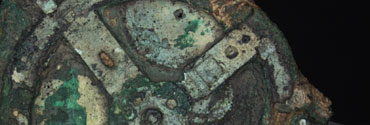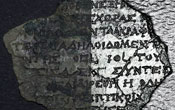
By Jamie Beckett, Dec. 2006
It spent more than 2,000 years at the bottom of the sea before
divers discovered the badly corroded bronze device near the Greek Island of Antikythera in 1900. Although scientists believed the geared mechanism to be some sort of mechanical calendar, its specific functions remained a mystery for more than a century.
Now, thanks in part to HP Labs' imaging technology,
scientists have been able to create a virtual reconstruction of what is now known as the Antikythera Mechanism.
Considered to be the oldest known mechanical calculator, the device was used to track the movements of the moon and the sun (and possibly the planets around Earth) and to predict the dates of future eclipses. According to scientists, no earlier geared mechanism of any sort has ever been found.
"Nothing as complex is known until you get to the Middle Ages, when people started building clocks," says Tom Malzbender, one of two HP Labs researchers who helped with the discovery.

Antikythera Mechanism fragment. The right side of the image has the enhancement turned on.
» View larger image
|
Malzbender and Dan Gelb got involved in the project a year ago, when members of the Antikythera Mechanism Research Project invited them to Athens to apply their patented reflectance imaging techniques to the deciphering process.
They used the technology to view the front and rear surfaces of the more than 70 fragments that comprise the mechanism, including metal plates and gears, some of which are inscribed with faded Greek characters.
Reflectance imaging involves taking photos of an artifact from a fixed point and 50 different light sources arrayed in a hemisphere over the object, and then stitching those images together. This allowed archaeologists to change the angle of light or texture of the surface of the object to make faint markings appear more vivid.
The results of this work in collaboration with researchers from the U.K. and Greece, appear in the November 29, 2006 edition of the British science journal, Nature ("Decoding the ancient Greek astronomical calculator known as the Antikythera Mechanism"). An X-ray technique, called computer tomography, was also used to probe the depths of the device.
The new research explains how the gears work and identifies twice as many markings on the device as previously detected.
|
